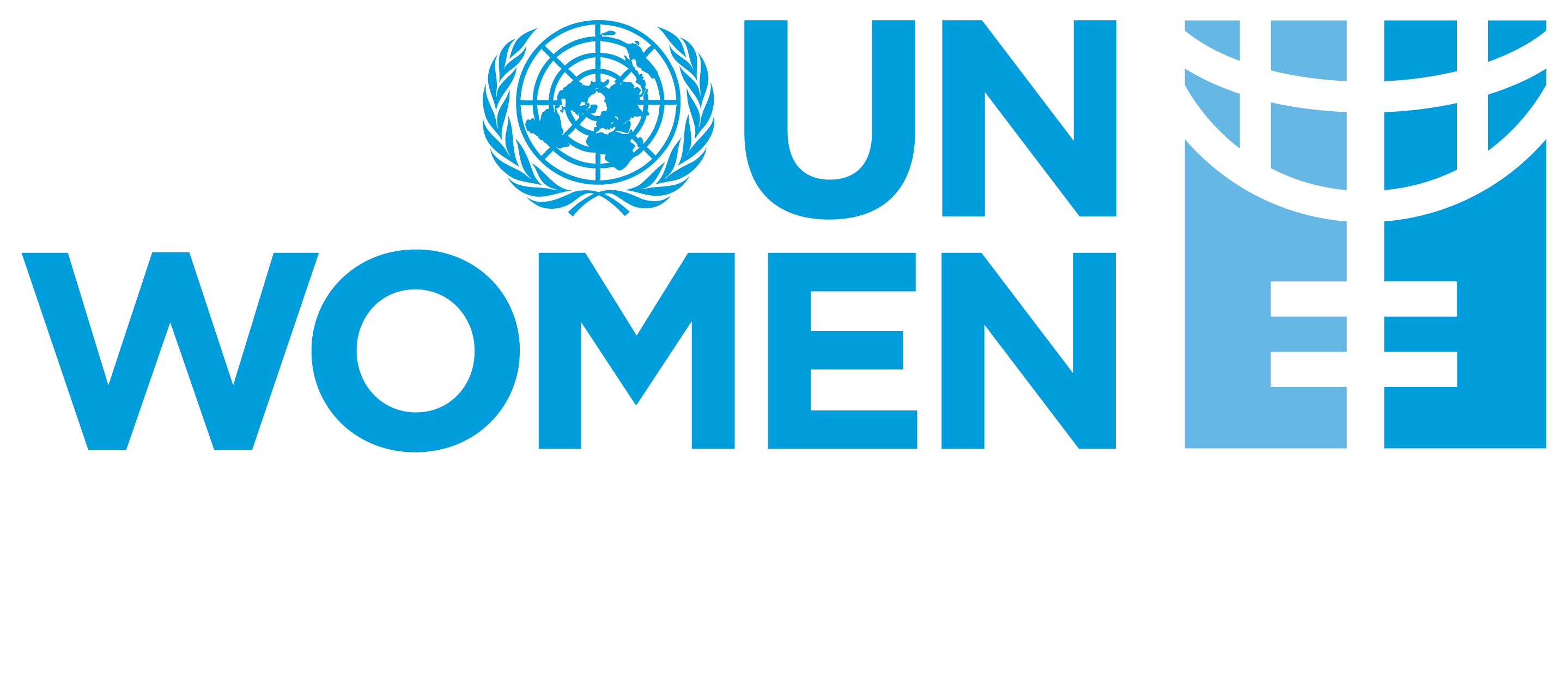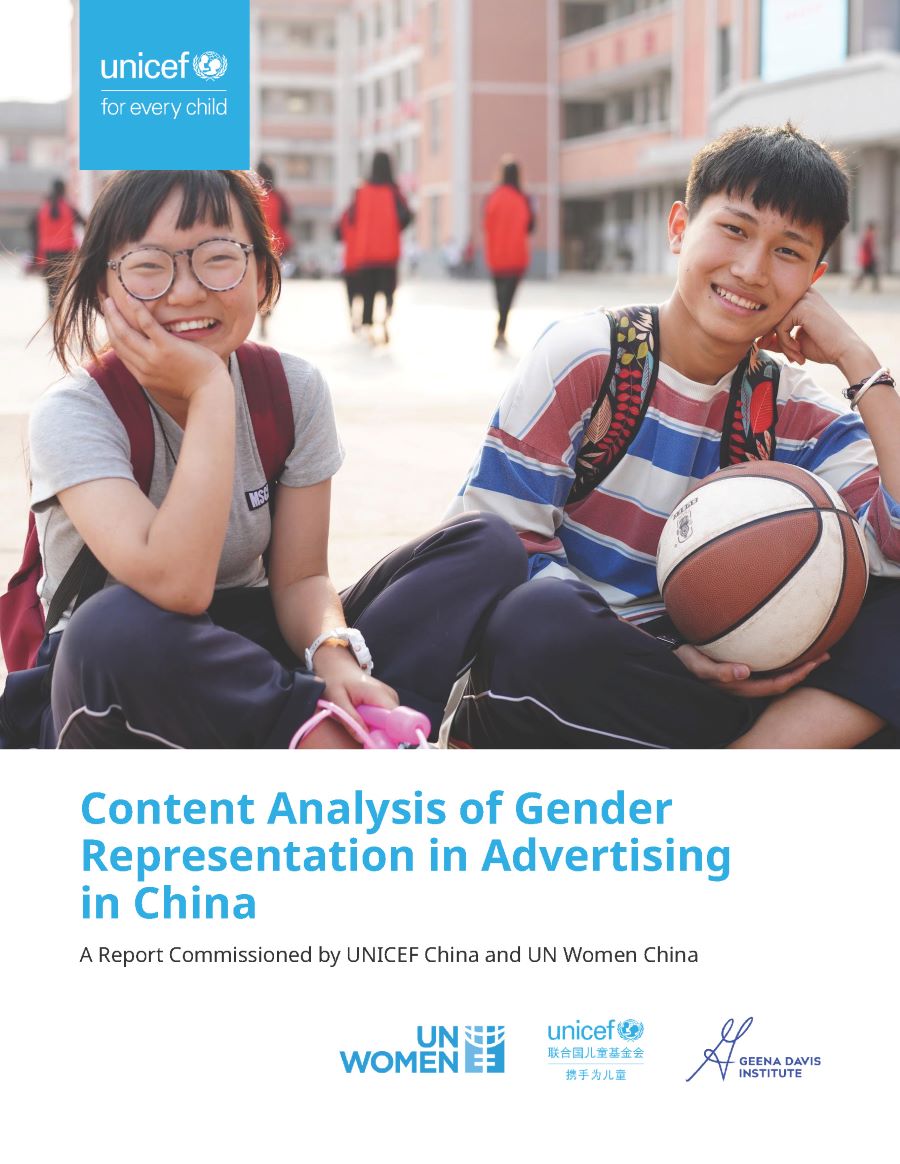

A Report Commissioned by UNICEF China and UN Women China
This report examines the portrayal of gender roles and stereotypes in 1,000 of the most widely viewed Chinese TV advertisements from 2022 to assess the state of gender representation in advertising in China, conducted by the Geena Davis Institute with support from UNICEF China and UN Women China. It explores how advertising shapes and reflects societal perceptions of gender, revealing significant imbalances such as the dominance of male characters in leadership and professional roles, and the over-sexualization and domestic confinement of women. Despite these disparities, some positive trends were found, including the depiction of women in outdoor settings and the equal representation of boys and girls in school contexts. The findings aim to provide insights to help advertisers create more balanced, empowering, and inclusive portrayals of gender, challenging harmful stereotypes and promoting a more equitable media landscape to improve gender representation in advertising in China.
Key Findings
- Men make up 55% of characters on screen and are three times more likely than women to be narrators. Compared to women, men are more visually prominent (54.6% compared with 45.4% of all characters) and are three times more likely to be narrators (63.4% of ads are narrated by only men, compared with 18.6% of ads narrated by only women).
- Women are four times more likely to be visually objectified and five times more likely to wear sexually revealing clothing. Sexualisation was measured by looking at whether characters were shown in sexually revealing clothing (such as a low-cut shirt), or if characters were visually objectified, which is when the camera (or another character’s vision) focuses on their bodies, such as their chest or their legs. Compared with men, women in advertising are more likely to be visually objectified (0.9% compared with 0.2%) and to wear sexually revealing clothing (3.4% compared with 0.7%).
- Men are 1.5 times more likely to be shown to have a paid occupation and almost twice as likely to be leaders. Male characters in ads are significantly more likely than female characters to be portrayed in a leadership capacity, and are more likely to be shown holding a paid occupation. Male characters are more likely than female characters to have a paid occupation (21.3% compared with 14.6%) and are almost two times more likely to be portrayed as leaders (2.8% compared with 1.5%).
- Women are nine times more likely to be shown cleaning and are more often shown in other domestic roles. A greater share of women than men are shown as caregivers to dependents (13.0% compared with 8.2%) and in a setting with their families (27.9% compared with 22.0%). Women are nine times more likely than men to be shown cleaning, which is a domestic activity (0.9% compared with 0.1%).
- Female characters are more likely to have a slim body type. Female characters are significantly more likely than male characters to have a slim body type (64.9% compared with 48.4%). Just 1.5% of female characters (and only 2.5% of male characters) are shown with a large body type, while the remaining share were deemed “average” body type. At the intersection of age, 68.5% of female characters ages 20 to 49, are slim, compared with 51.3% of male characters ages 20 to 49; 25.5% of female characters who are 50-plus are slim, compared with 23.1% of male characters who are 50-plus.
- There are no gender differences in STEM professionals shown in ads. Of characters with a paid occupation, 11.1% of men and 9.5% women were shown in a STEM occupation, a difference that is not statistically significant.
- Young boys and girls are shown in school at a similar rate in ads. About 8% of girls under 12 and 7% of boys under 12 are shown in a school setting in ads, a difference that is not statistically significant.
Recommendations
- Develop content that positions women and girls as leaders and challenges harmful stereotypes and normalised beliefs around violence against women and girls.
- Increase the share of women and girls across advertisements and ensure they have prominent speaking and narrating roles.
- Show female and male characters in counter-stereotypical roles related to their genders.
- Create alternative depictions of femininity by portraying women and girls in ways that do not reduce their worth to sexualisation.
- Depict women in the workplace, in positions of authority, as leaders, and with power.
- Build alternative depictions of masculinity by portraying men and boys in more diverse ways so as not to reduce their worth to harmful and simplistic stereotypes.
- Depict men as caregivers, contributing to household duties, experiencing a range of emotions, and showing vulnerability.
- When portraying household settings, reflect the reality of diverse family units, including multigenerational households, single-mother-led or single-father-led families, and other situations outside of the nuclear family.
- Strengthen content-quality testing and evaluation mechanisms.
- Leverage tools to create and track advertising content that is free of gender stereotypes, and push for progressive portrayals of all people.
- Test advertising scripts for bias among diverse audiences, including children and adolescents.
- Conduct impact assessments with diverse stakeholders, including consultations with children and adolescents, to understand how marketing can impact their perceptions of themselves and others.
- Maintain gender-sensitive advertising practices by raising awareness and capacity building.
- Train staff regularly (especially senior management, advertising production, and creative teams) on unconscious bias, including how our perceptions impact content development and marketing choices in a way that promotes or challenges harmful gender norms.
- Develop a long-term strategic plan and commitment to diversity, equity, and inclusion in marketing and advertising.
- Hire diverse teams of writers, producers, and artists and ensure that they can bring new perspectives and experiences to the creative and production process.
- Use distribution channels that ensure inclusive and non-discriminatory marketing mechanisms, including preventing the use of gender-biassed algorithms in digital platforms.
- Use data to address stereotyping regarding race, disability, sexuality, and age.
- Practise positively gendered marketing and promote positive gender socialisation to women and girls by focusing on traits such as intelligence, strength, and perseverance rather than just attractiveness, thinness, and domesticity.
- Establish guidelines for advertising with benchmarks for gender-equitable representation.
- Develop partnerships and collaborations with gender-equality organisations.
- Partner with gender-equality organisations and women-led media groups to identify appropriate ways to use marketing and advertising channels to promote messages that dismantle harmful stereotypes and combat violence against women and children.
How to cite this study:
GDI, UNICEF China, & UN Women China. (2024). Content Analysis of Gender Representation in Advertising in China: A Report Commissioned by UNICEF China and UN Women China. Geena Davis Institute, United Nations Children’s Fund (UNICEF) China & UN Women China.
Previous reports
See our previous global advertising studies in partnership with UNICEF:
- A Review of Advertising in the Caribbean and Its Links to Gender Equality, Gender Norms, and Violence against Women and Girls (2022)
- A Review of Advertising in Mexico and Its Links to Gender Equality, Gender Norms, and Violence against Women and Girls (2022)
- Gender Bias and Inclusion in Advertising in India (2021)
And check out some of our other advertising studies below:
- Gender Bias in Advertising: Research, Trends and New Visual Language (2017)
- Equal Play? Analyzing Gender Stereotypes, Diversity, and Inclusion in Advertising and Marketing of Toys (2022)
- Inclusive Advertising in Sweden (2021)
- Championing Diversity in Online Advertising: A Collaborative Study with Facebook (2021)
- The Power of Portrayal: Representation in Cannes Lions Film and Film Craft Shortlisted and Winning Work, 2006 to 2023 (2023)
- Purpose-Driven Progress: Advancing On-Screen Diversity and Inclusion Through Accountability (2022)
- Bias & Inclusion in Advertising: An Analysis of 2019 Cannes Lion Work (2020)
- Bias & Inclusion in Advertising: An Analysis of 2018 Cannes Lions Film Craft Ads (2019)
